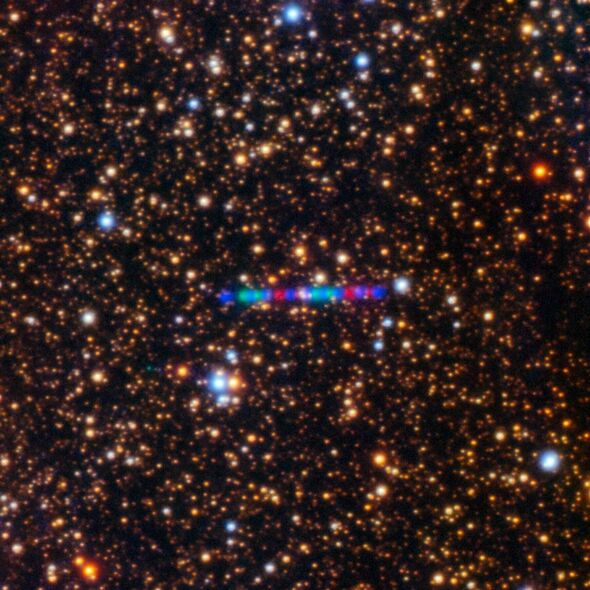Science
Congresswoman Demands NASA Release Data on 3I/ATLAS Object

Growing concerns about an object termed a “Manhattan-sized alien spaceship” have led to calls from U.S. Congresswoman Anna Paulina Luna for NASA to disclose withheld data regarding 3I/ATLAS. The Florida Republican emphasized the need for transparency to enhance public understanding of these interstellar visitors as the object approaches Earth.
In a post on social media platform X, Congresswoman Luna stated, “I write to request the release of specific observational data related to 3I/ATLAS, recently captured by NASA missions.” She highlighted the importance of this information for advancing knowledge about how such celestial bodies interact with our solar system. Luna specifically requested images taken by the HiRISE camera aboard the Mars Reconnaissance Orbiter during the period of October 2 to 3. Additionally, she sought “supplementary data” from both the Mars Orbiter and the Perseverance Rover, as well as other Mars missions that may have detected unusual activity near Mars around October 3, 2025, when 3I/ATLAS passed within approximately 30 million kilometers (or 18.6 million miles) of the planet.
The urgency of this request follows reports that the space object has unexpectedly accelerated from 130,000 mph to 152,000 mph. Scientists have noted an “extra kick” pushing the 12-mile-wide object off its expected trajectory, an anomaly that cannot be solely attributed to the sun’s gravitational influence. The sun, which contains nearly all of the solar system’s mass, typically exerts a consistent gravitational pull that keeps celestial bodies on predictable paths. Yet, the recent behavior of 3I/ATLAS has raised questions about existing gravitational models.
While NASA attributes this increase in speed primarily to the sun’s gravity, experts are grappling with the reasons behind 3I/ATLAS’s significant deviation from its predicted path. Most scientists believe this space rock is a comet that has traveled to the sun from another star over billions of years. However, Avi Loeb, a theoretical physicist from Harvard University, posits that 3I/ATLAS could potentially be an “extraterrestrial artifact” nearing first contact. He suggests that the object’s acceleration and distinctive blue color may indicate artificial origins.
If 3I/ATLAS were a typical comet, it would ordinarily release gas jets as it nears the sun, causing it to alter its course. Yet, Professor Loeb points out that astronomers are still awaiting evidence that 3I/ATLAS has emitted sufficient gas to confirm its identity as a comet. The object is expected to reach its closest point to Earth in just six weeks, leading Loeb to assert that if no gas cloud is detected from the object, it could indicate that its recent speed increase was propelled by an extraterrestrial rocket engine.
As this situation develops, NASA’s response to Luna’s request and the ongoing investigation into the nature of 3I/ATLAS will be closely monitored by both the scientific community and the public. The implications of this research could significantly enhance our understanding of interstellar objects and their potential interactions with our solar system.
-

 World3 weeks ago
World3 weeks agoGlobal Air Forces Ranked by Annual Defense Budgets in 2025
-

 World3 weeks ago
World3 weeks agoMass Production of F-35 Fighter Jet Drives Down Costs
-

 Science3 weeks ago
Science3 weeks agoTime Crystals Revolutionize Quantum Computing Potential
-

 World3 weeks ago
World3 weeks agoElectrification Challenges Demand Advanced Multiphysics Modeling
-

 Top Stories3 weeks ago
Top Stories3 weeks agoNew ‘Star Trek: Voyager’ Game Demo Released, Players Test Limits
-

 Business3 weeks ago
Business3 weeks agoGold Investment Surge: Top Mutual Funds and ETF Alternatives
-

 Top Stories3 weeks ago
Top Stories3 weeks agoDirecTV to Launch AI-Driven Ads with User Likenesses in 2026
-

 Lifestyle3 weeks ago
Lifestyle3 weeks agoDiscover Reese Witherspoon’s Chic Dining Room Style for Under $25
-

 Entertainment3 weeks ago
Entertainment3 weeks agoFreeport Art Gallery Transforms Waste into Creative Masterpieces
-

 Health3 weeks ago
Health3 weeks agoGavin Newsom Critiques Trump’s Health and National Guard Plans
-

 Business3 weeks ago
Business3 weeks agoUS Government Denies Coal Lease Bid, Impacting Industry Revival Efforts
-

 Politics2 weeks ago
Politics2 weeks agoLanguage Evolution: New Words Spark Confusion in Communication









